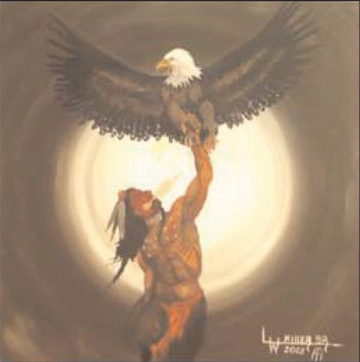
Yankton Dakota Lyle Miller Sr.’s “The Taking of Honor” piece was featured in Cowboys & Indians magazine and is now at home in Barcelona, Spain. PHOTO COURTESY/LYLE MILLER SR.
MITCHELL, SOUTH DAKOTA –– This year marks 150 years since the Sioux Uprising, or the Dakota War, of 1862. The uprising was a six-week armed conflict along the Minnesota River, beginning on Aug. 17, 1862, between the Dakota and white settlers and later involving the U.S. Army. It ended on Dec. 26 of that same year in Mankato, Minn., with the President Abraham Lincoln-sanctioned hanging of 38 Dakota men in the largest single-day mass execution in U.S. history. The executions led to the eventual surrender of the Dakota people. Now, Lyle Miller Sr., a Yankton Sioux Tribe member, is honoring his fallen ancestors in the most respectful way he can – through his art. “I’ve been doing a lot of things with Native American spirituality, predominantly paintings that have to do with the hanbleca, the seeking a vision,” said Miller. Lately, he’s been painting on canvas via acrylic paints to create his work, but he also specializes in bronze work. Miller recently had an art show at Crow Creek Tribal Schools’ year-end powwow. His work has been acquired and showcased in various locations, most notably in an upcoming exhibit by the Minnesota Historical Society in St. Paul. The historical society has commissioned the 47-year-old artist and teacher to create a piece for a gallery that will commemorate the Sioux Uprising. According to their website, the MHS, founded in 1849, “collects, preserves and tells the story of Minnesota’s past through museum exhibits, libraries and collections, historic sites, educational programs and book publishing.” The Minnesota History Center, which serves as the headquarters for the Minnesota Historical Society, will showcase documents, artifacts, and artwork related to the Sioux Uprising and will examine its aftermath in this sesquicentennial year. The new exhibit – including Miller’s work – is scheduled to open to the public on June 30. Miller says he is really proud of the work he contributed for the exhibit. “They see that the descendants (of the Sioux Uprising) are alive and well after that terrible event – our people are still alive,” said Miller. Miller credits his kindergarten teacher from Mitchell with introducing him to the art world. He recalled being withdrawn as a kid, and his teacher encouraged him to draw pictures in order to better express himself. “Once I knew what I could do with my hand and eyes, then put it down on paper, it took off like wildfire,” he said. Miller graduated in 1993 from Dakota Wesleyan University with a bachelor’s degree in art. He also joined the military during his college tenure. Subsequently, he taught art at CCTS to elementary and middle school kids for 15 years. He now teaches Dakota language in the same school system in order to help preserve his Native speech. However, he said he’s only been doing art professionally since 2005 and works on his art during the summertime. He produces his pieces from his own home studio in Mitchell. And his two sons are carrying on the “artist dynasty,” as he calls it. Another source of inspiration comes from the memory of Miller’s wife of 24 years, who lost a battle with cancer in 2006. He said she was the one who urged him to start putting his art out and to sell it. A lot of his recent paintings have a white center in the background, which he does as a tribute to her. One of his greatest accomplishments as an artist so far is his piece entitled “The Taking of Honor,” which appeared in the March 2009 issue of Cowboys & Indians magazine. The piece depicts a Native American warrior reaching upward, grasping an eagle with one arm. It’s based on the traditional practice of retrieving eagle feathers – symbols of honor. He said the original painting was later purchased by a woman from Barcelona, Spain. With 150 years having passed since the Sioux Uprising, Miller is glad to be a part of the healing process between peoples. “It’s a beautiful thing to be a part of it, 150 years later, after all of that violence,” said Miller. Some of Miller’s artwork can be viewed on Facebook at the Mystic Horse Art Studio page. (Contact David Arredondo at layout@nsweekly.com)
Join the Conversation
